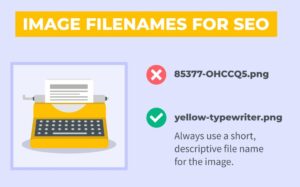In the visually-driven world of the internet, image optimization is a crucial component of SEO strategy. Optimized images not only enhance the user experience but also contribute to improved search engine rankings. In this comprehensive guide, we’ll explore the intricacies of image optimization for SEO and provide actionable tips to ensure your website’s visuals are working in harmony with search engines.
Understanding the Importance of Image Optimization
Before diving into the specifics, it’s essential to understand why image optimization matters for SEO. Search engines use various factors to determine rankings, and images play a significant role in this process. Optimized images contribute to faster page loading times, improved user experience, and accessibility. Additionally, search engines consider factors like file names, alt text, and surrounding content to comprehend the context of an image.
Choosing the Right File Format
The choice of file format can impact both image quality and loading speed. The most common image formats for the web are JPEG, PNG, and GIF. Each format has its strengths and best use cases:
JPEG: Ideal for photographs and images with gradients. It offers a good balance between file size and image quality.
PNG: Suitable for images with transparency or crisp edges, such as logos and icons. PNGs usually have larger file sizes than JPEGs.
GIF: Best for simple images, animations, or images with a limited color palette.
Understanding the characteristics of each format allows you to choose the most appropriate one for your specific image.
Resizing Images for Web Use
Large, high-resolution images can significantly slow down your website’s loading speed. Resize images to the exact dimensions required for display on your site. You can use image editing tools like Photoshop, GIMP, or even online tools like TinyPNG to resize images without compromising quality.
WordPress also offers built-in image resizing options. In the Media Library, you can select different image sizes (thumbnail, medium, large) when inserting images into your posts. This ensures that your site only loads the image sizes needed for specific areas, reducing unnecessary data transfer.
Compressing Images for Optimal Performance
Image compression is a critical step in optimizing website images. Compression reduces the file size of an image without significant loss of quality. This is particularly important for ensuring fast loading times, a key factor in both user experience and SEO.
There are various tools available for image compression, both online and offline. Tools like TinyPNG, ImageOptim, or plugins like Smush for WordPress can automatically compress images during the upload process. Striking the right balance between image quality and file size is key to effective compression.
Optimizing File Names and Alt Text
 Search engines rely on file names and alt text to understand the content and context of images. When saving images, use descriptive file names that convey the image’s subject. For example, instead of “IMG_123.jpg,” use a name like “blue-widget-product.jpg” for a product image.
Search engines rely on file names and alt text to understand the content and context of images. When saving images, use descriptive file names that convey the image’s subject. For example, instead of “IMG_123.jpg,” use a name like “blue-widget-product.jpg” for a product image.
Alt text (alternative text) is a brief, descriptive text that appears when an image can’t be displayed. It serves as an accessibility feature for users with visual impairments and is crucial for SEO. Include relevant keywords in your alt text while ensuring it accurately describes the image.
In WordPress, you can easily add alt text when uploading an image through the Media Library. This is a simple yet impactful step in optimizing images for both search engines and users.
Utilizing Image Sitemaps
Image sitemaps provide search engines with additional information about the images on your site. By creating and submitting an image sitemap to search engines, you can ensure that your images are properly indexed. This can improve the chances of your images appearing in image search results.
Most SEO plugins for WordPress, such as Yoast SEO or Rank Math, automatically generate image sitemaps for your site. Ensure that your sitemap is up-to-date and regularly resubmit it to search engines through Google Search Console.
Leveraging Lazy Loading for Improved Performance
 Lazy loading is a technique that defers the loading of images until they are about to come into the user’s viewport. This can significantly improve page loading times, especially for websites with numerous images.
Lazy loading is a technique that defers the loading of images until they are about to come into the user’s viewport. This can significantly improve page loading times, especially for websites with numerous images.
Many modern WordPress themes and plugins come with built-in lazy loading features. Alternatively, you can use JavaScript libraries or plugins like Lazy Load by WP Rocket to implement lazy loading on your site. This ensures that images are loaded only when they are needed, reducing initial page load times.
Implementing Responsive Images
With the prevalence of various devices and screen sizes, responsive design is essential. Ensure that your images are responsive and adjust dynamically based on the user’s device. This prevents large images from slowing down mobile devices and contributes to a seamless user experience.
WordPress automatically creates responsive images by default. However, it’s essential to test your site on different devices to confirm that images are rendering correctly. Tools like Google’s Mobile-Friendly Test can help identify any issues related to responsive image display.
Regularly Auditing and Updating Images
SEO is an ongoing process, and the same applies to image optimization. Regularly audit your website’s images to identify any that may need updating or further optimization. This is particularly important if you frequently add new content or update existing pages.
Tools like Google PageSpeed Insights can provide insights into your site’s image optimization and offer suggestions for improvement. Take the time to address any issues highlighted by such tools to ensure your images continue to contribute positively to your site’s SEO.
Conclusion: Elevating Your SEO Game with Optimized Images
In the ever-evolving landscape of SEO, image optimization is a non-negotiable element of a successful strategy. By strategically choosing file formats, resizing, compressing, and optimizing images for search engines, you can enhance both user experience and search engine rankings.
WordPress, with its user-friendly interface and a variety of plugins, makes image optimization accessible to website owners of all levels of expertise. By incorporating the tips outlined in this guide, you can ensure that your website’s visuals not only captivate your audience but also align seamlessly with search engine algorithms, propelling your site to new heights in search rankings.
